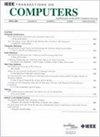Towards Effective Local Search for Qubit Mapping
IF 3.6
2区 计算机科学
Q2 COMPUTER SCIENCE, HARDWARE & ARCHITECTURE
引用次数: 0
Abstract
In the era of noisy intermediate-scale quantum (NISQ), a quantum logical circuit must undergo certain compilation before it can be used on a NISQ device, subject to connectivity constraints posed by NISQ devices. During compilation, numerous auxiliary quantum gates are inserted, but a circuit with too many is unreliable, necessitating gate minimization. This requirement gives rise to the qubit mapping problem (QMP), an NP-hard optimization problem that is critical in quantum computing. This work proposes a novel and effective local search algorithm dubbed量子比特映射的有效局部搜索
在噪声中尺度量子(NISQ)时代,受NISQ器件的连通性约束,量子逻辑电路必须经过一定的编译才能在NISQ器件上使用。在编译过程中,会插入许多辅助量子门,但过多的电路是不可靠的,因此需要最小化门。这一要求产生了量子比特映射问题(QMP),这是一个NP-hard优化问题,在量子计算中至关重要。本文提出了一种新颖有效的局部搜索算法——effective qm。首先,effecveqm提出了一种新的模式感知搜索策略,以缓解局部最优的挑战,而局部搜索通常会受到影响。此外,effecveqm引入了一种新的电位引导评分函数,可以彻底量化插入辅助门操作带来的实际效益。通过合并潜在引导评分功能,effecveqm可以有效地确定要执行的适当操作。在多种逻辑电路和6个NISQ设备上进行的大量实验表明,与目前最先进的QMP算法相比,EffectiveQM可以用更少的插入辅助门生成物理电路,这表明EffectiveQM大大提高了QMP求解的技术水平。
本文章由计算机程序翻译,如有差异,请以英文原文为准。
求助全文
约1分钟内获得全文
求助全文
来源期刊

IEEE Transactions on Computers
工程技术-工程:电子与电气
CiteScore
6.60
自引率
5.40%
发文量
199
审稿时长
6.0 months
期刊介绍:
The IEEE Transactions on Computers is a monthly publication with a wide distribution to researchers, developers, technical managers, and educators in the computer field. It publishes papers on research in areas of current interest to the readers. These areas include, but are not limited to, the following: a) computer organizations and architectures; b) operating systems, software systems, and communication protocols; c) real-time systems and embedded systems; d) digital devices, computer components, and interconnection networks; e) specification, design, prototyping, and testing methods and tools; f) performance, fault tolerance, reliability, security, and testability; g) case studies and experimental and theoretical evaluations; and h) new and important applications and trends.
 求助内容:
求助内容: 应助结果提醒方式:
应助结果提醒方式:


